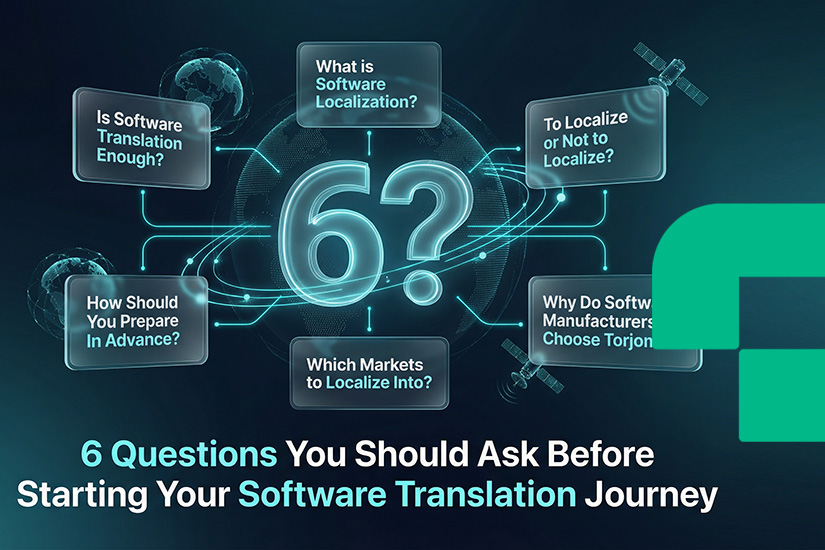What if your software product fails in the local market?!
Big issue (isn’t it?) which needs a complete revisit of the whole project from A to Z, and from strategy to tactics? On the contrary, what if your incredible software product proves to be a great success in your local market? Will you then lie down, take a break and relax, or you’ll promptly consider how to sell it overseas in global markets?
Since the question and the answer are both self-explanatory, you’ll definitely think about growing with the software on an international level. Good, so the more important question will arise: How you’ll make it happen?
Well, you’ll then make a daring decision. You’ll think this way: Since globalization is providing my business with a limitless market for my software product, so be it! If it’s successful in my home country, where people speak a certain language, why not try it out in overseas markets ─ in Africa, Asia, Europe, America, etc.?
This is how the argument goes, with you most probably coming to the conclusion that your company has to translate the software product. So, let’s do it, let’s translate the software into other languages!
Is Software Translation Enough?
When you start the task of translating software products, programs and applications into multiple languages, you’ll definitely face this fact of life (and business!): It’s categorically not enough for a program or software product to support multiple languages!
Yes. Users in overseas markets, who speak other languages, may be able to view the user-facing parts of the software product translated into their own languages; but if you’ve just translated the words and nothing more, they will probably face the hell of usability difficulties.
With a software that has been only translated, say, from English into Chinese, the font will be too small to read, and the images will have a British or American look and feel, with the result that the Chinese user would feel that the whole product is foreign to him or her. (Oh, not so good to make a customer alienated!)
With this said, your translated software product isn’t making sense for consumers in foreign countries and foreign markets. My God! It’s not global – it’s just multilingual. So, a hellish question will defiantly keep popping up: What’s missing?
And the answer will also pop up – clear and straightforward: Software Localization!
What is Software Localization?
Before we come out with any description of software localization, let’s first ask ourselves a series of interdependent questions. Doesn’t it sometimes happen (at the best of families!) that a software user may notice a foreign cultural convention in a software product? Why would he or she immediately notice this irregularity? And why does the user normally rush to a conclusion that this product was not designed with her language (and her culture) in mind?
Again, the answer is SOFTWARE LOCALIZATION. Then, let’s move on to the more important point: What is software localization?
The answer consists of 4 words (if you don’t count the articles and pronouns): Fitting your software product to your audience! Therefore, it’s fair to describe software localization as the process of adapting your software product to the culture, the language and the legal setting of the end user’s locale. This covers such areas as user interface, images, documentation, standards of measurement, video and graphic design, etc.
And since you might by now have become fully aware that software localization isn’t luxury, but a necessity for expanding your business into global markets, or, in other words, for making your software usable and effective for users speaking other languages, it’s time for you to ask yourself a number of critical questions whose answers will prepare you for starting your product localization journey. So, let’s take the questions one by one.
To Localize or Not to Localize?
This would logically be the first question, and we’ve got 3 possible answers on hand. First, If the software product is deemed useful only for your specific market, it’s probably not a good idea to consider localizing the software ─ at least for the time being.
The second scenario is when you see it more feasible to direct your attention to your home market for the time being, but your eyes would be simultaneously focused on doing it at a later stage. In this case, you need to do some preliminary activities, such as adding number file formats and international character, in preparation for the localization effort in the future.
The third scenario is when you have an overseas audience, or you’re likely to get one; so the answer is “do it and do it quickly”!
How Should You Prepare In advance?
Let’s put it straight from the shoulder. Before you start localization, you need to take another step, namely the internationalization of your software ─ a stage that aims to separate the source code from any localizable elements, thus making it easier and faster to adapt the product to a new market.
Besides, before you embark on the localization project, you have to understand local regulations and legal requirements of the new target market, including such areas as data protection, terms of service, privacy, etc.
Which Markets to Localize Into?
According to most marketing and communication experts, before starting the localization effort, the software maker should put in place a clear market positioning strategy that studies the competition and explores how the software will fit into the new market ─ with a view to coming up with a market positioning that distinguishes the product and thus appeals to users. Based upon this strategy, you will easily decide which markets to localize your software into.
And now, it might be the time to ask the final questions of who to choose as your software localization partner ─ and why. The answer, however, is in the next paragraph!
Why Do Software Manufacturers Choose Torjoman?
Torjoman adopts a specific approach which revolutionizes the way software products are localized for success in international markets. Our second-to-none localization solutions are intentionally designed to accelerate swift development on all platforms.
At Torjoman, each client’s localization project is run by a devoted project manager, who is dedicated to studying the product material in depth, agreeing on the service’s rates, choosing the right team of localizers and engineers, managing deadlines and all other tasks. Above all, the project manager is available 24/7 at your disposal.
From applications for all operating systems to firmware, customer relationship management applications, payroll and billing software, mobile apps, inventory and asset management software, enterprise resource planning systems and all other types of software products, Torjoman has over the years established a global reputation for localizing software products in a way that helps the company’s clients ─ big names of software makers, small & medium enterprises as well as startups ─ to provide optimal user experience for users who speak different languages across the world.
The net result of this long journey of hands-on experience is that almost all our customers recommend our software localization services to others.
Let’s do something special for you too. Contact us for a free quote.







